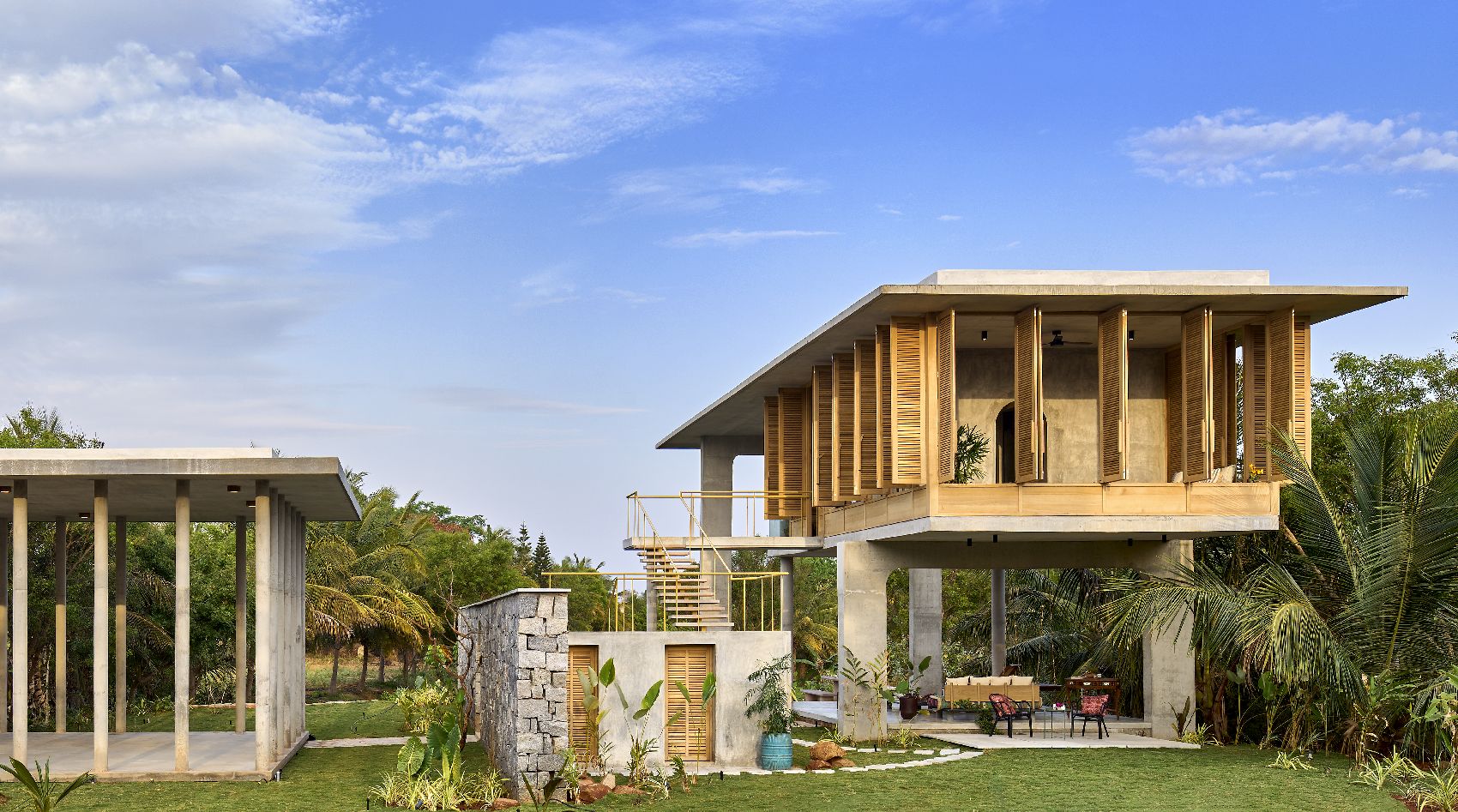Nestled in lush coconut and areca tree plantations with the mighty Savandurga Hill – one of the largest monolith hills in Asia – framing its backdrop, Ksaraah is a weekend retreat in rural Bengaluru, India, that reimagines living in the embrace of nature. It aims to foster a direct connection with the outdoors, sans boundaries, while still sheltering its inhabitants – a creative professional and her family.

The primary design challenge was to create a built environment that would belong within its context – one that would blend, harmonise, and inspire, rather than shock and dominate. The design intervention, therefore, ensures minimum deviation from the existing landscape, while providing a space with limitless opportunities for the users to thrive in.

The two-storeyed primary residence, an interplay of volumes and voids, is perched atop the site’s highest level, framing views of the farms that lie on the horizon. Resting weightlessly on a set of two loft, bevelled arches, it creates expansive column- and wall-free spans with deep overhangs. The ground floor hosts communal spaces like the living, the dining, and a sit-out area that are seamlessly entwined with nature; the master bedroom and its ensuite bathing chamber and a private study lounge occupy the first floor.

On the first floor, arched elements punctuate the space complementing the stark linearity of the structure. Tall, louvered windows in oak wood traverse the floor’s perimeter, creating a permeable envelope that invites trees and plants into the indoors, while allowing the users to control ventilation and daylighting.

The spatial arrangement is specifically directed to traverse amidst the landscape, blurring the boundaries between the built and the unbuilt. A sleek, exterior staircase connects the two levels next to a pool – the epicentre of the residential quarters – its backdrop marked by a feature stone wall. The wall creates a three-dimensional site partition and marks the transition between the private and public functions of the house, while unifying the visual narrative.

An Exercise in Placemaking
More than just catering to the needs of its inhabitants, Ksaraah aims to address the needs of the local community. The design is focused on creating adaptable, multi-use, congregational spaces to bring people together and to foster activities and conversations. The idea to humanise, equalise and spiritualise holds strong.

At the heart of the site stands the eighty-foot-long Pavilion composed of rhythmic modules that are orderly and aesthetic. A dynamic progression of circular columns stipple its perimeter, referencing the surrounding plantations; it is designed to ‘disappear’ once the surrounding trees grow to their maximum heights.

The Pavilion is a dynamic arena of sorts; always bustling with energy, this recreational space can host an evening soiree, an artistic installation, a dance recital, or a musical rendezvous with equal flair. Open to all including the local villagers, the Pavilion has been used as a classroom during the pandemic by the local school and hosted a play as part of the annual village function jatre.
The cellar of the residential quarters, whichhousesa studio for the inhabitants to profoundly delve into their creative processes, can also be used to engage with fellow artists on collaborative projects.

A Feast for the Senses
Ksaraah creates a sanctum of rejuvenation away from urban bustle. It is designed to continually transform; nature is the protagonist.
The play on the sensual and perceptual abilities of the inhabitants is heightened and is ever changing as one traverses through the spaces. The effects of volume, light, shadow and textures in each space are designed to be specific to its function and the time of the day it is to be used. The same spaces seem very different when they are closed or open; when open, they feel like you are amidst the landscape and when they are closed, they offer a cosy, warm ambience. The louvers enveloping the first floor of the residential quarters look different with each passing hour, altering the spatial quality of the indoors according to the time of the day and the weather outside. The quality of light in the living spaces changes throughout the day and in the evening, the whole volume appears to almost float above the plantations.

The Sun traces visual poetry as it descends upon the Pavilion too, its series of columns creating a rhythmic play of light and shadows.
Spaces act as a bare canvas for self-exploration and self-expression. Monochromatic concrete and cement finishes blend into the grey background on a dark, cloudy day. They are coupled with warm oak wood, which glistens in the sun and softens the architecture. Locally-sourced stones like Sadarahalli and Pink Magadi complete the textural leitmotifs of the residence. This spectrum of materials is pieced together keeping in mind that they age gracefully and require minimal maintenance – so surfaces develop a timeless patina over time and merge within the landscape.

Being One with Nature
The design intervention was consciously limited in terms of changing the landscape or the natural occurrences within the site to ensure that the processes of shrishti (creation), stithi (sustenance) and samhara (dissolution) continue without any interruption.

Materials were chosen to last long. Stones were sourced locally from nearby quarries; waste stones were recycled into furniture. In the interiors, the khadi bedding and toiletries are all natural. Soft furnishings are a celebration of traditional Indian craftsmanship such as the kansacrockery.

Solar energy powers the entire building. To reduce the need for mechanical air conditioning, unwanted wall envelopes are negated and are instead replaced with plants and trees. Breathing walls for the sheltered spaces reduce indoor temperatures by an index of 4 degrees, ensuring optimal, natural air circulation and daylighting throughout the day. The pool, designed to catch the flow of the NE-SW breeze, also aids in evaporative cooling and creates a comfortable microclimate on the site. The cellar with its stone walls and the earth filling around it remains cool throughout the year.

The pool without any filtered or added chemicals doubles up as a storage tank for the vegetation around. Waste water from the household is recycled and channelled towards farming activities, nurturing the plantations of chikoo, mango, and banana trees on the site. Sculptural trees and flowering species are braided into the existing flora, densifying the greenery that will eventually thrive.
Other images can be seen in the gallery down below
Typology: Retreat Residential (Weekend Home)
Name of Project: Ksaraah
Location: Bangalore Rural
Principal Architect: Ar. Shalini Chandrashekar and Ar. G.S. Mahaboob Basha
Design Team: Siri / Yatheesh Kune / Vishnu Naidu
Site Area (sq ft & sq m): 4.00 Acres
Built-Up Area (sq ft & sq m): 487.00 Sqmts (5249.00 Sft)
Start Date: 14th of January 2019
Completion Date: 14th of March 2021
Photographer: Harshan Thomson
About Taliesyn - Design & Architecture
Taliesyn strives to conceptualize Architectural and Design solutions that inherently fulfil the sole intention of creating meaningful and appropriate spatial interventions.
After having garnered extensive experience at prestigious design studios, Ar. Shalini Chandrashekhar and Ar. G. S. Mahaboob Basha joined forces to co-found Taliesyn in the year 2010 in Bangalore. With over 10+ years of experience in the realm of design, the studio’s practice is sculpted based on the notion of people, spaces and objects being in continuous dialogue with each other — it is this evolving interaction that drives the studio’s impetus to create spaces in various domains of architecture. The firm has projects dotting the Southern-Indian frontier ranging a diverse portfolio of Residential, Hospitality, Recreational, Institutional and Cultural genres of design.
The design tools curated by the studio enhance the in-house research processes and also catapult the evolution of the conceptual frameworks. The spatial quality in the firm’s vision is a balanced concoction of emotional sensibilities, and tangibility of design comes through in the form of detailed design processes. Exploration of materials based on their proximity to the site, physical properties, appearances and the effect it introduces into a space is of paramount importance in each project. Taliesyn strongly endorses the use of local materials to promote sustainability in their practice.
The practice’s design philosophy involves decoding the purpose of the brief based on the processes of planning, analysis and detailing — resulting in an architecture that is deeply rooted to the landscape and one that responds to the vernacular paradigm of the site and the materiality.
Taliesyn’s practice and body of work are strung together by a common thread of contextual sensitivity and architectural experiences that engage the senses in a holistic manner — spaces that strike the equilibrium between the needs of the end-users, aesthetics and the ideologies of the studio. With a dedicated team, Taliesyn’s design endeavours are fueled by the collaboration and expertise of a spectrum of seasoned consultants, engineers and professionals. The studio’s creations are an amalgamation of Shalini and Mahaboob Basha combined poetic vision and an approach based in the gravitas of design, having won accolades both nationally and internationally.

